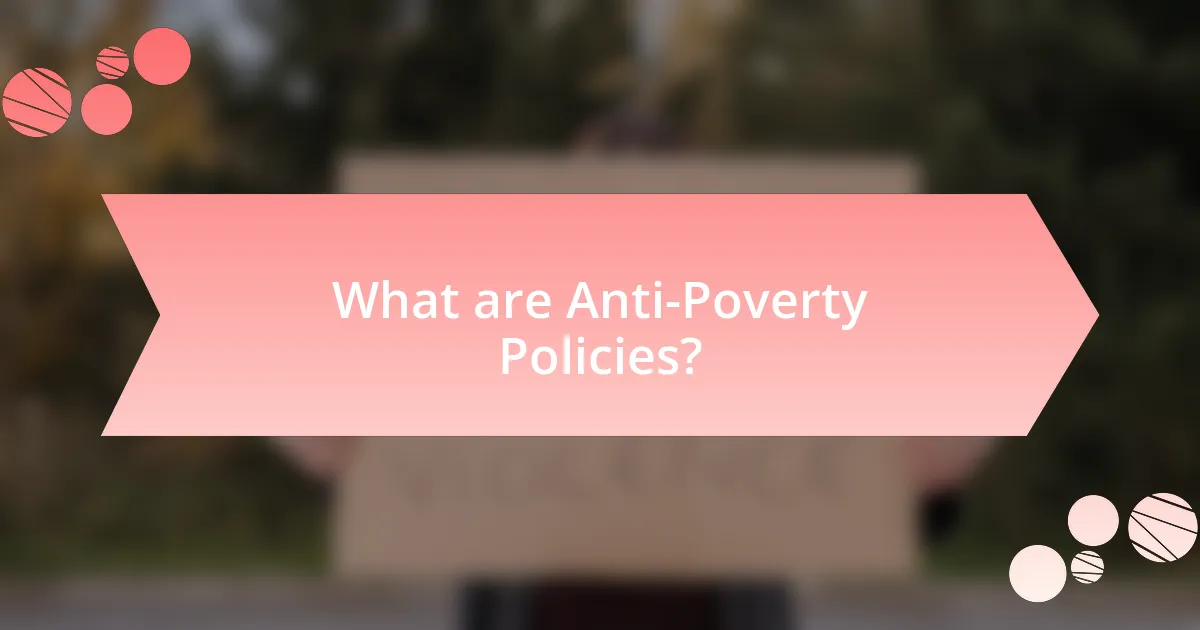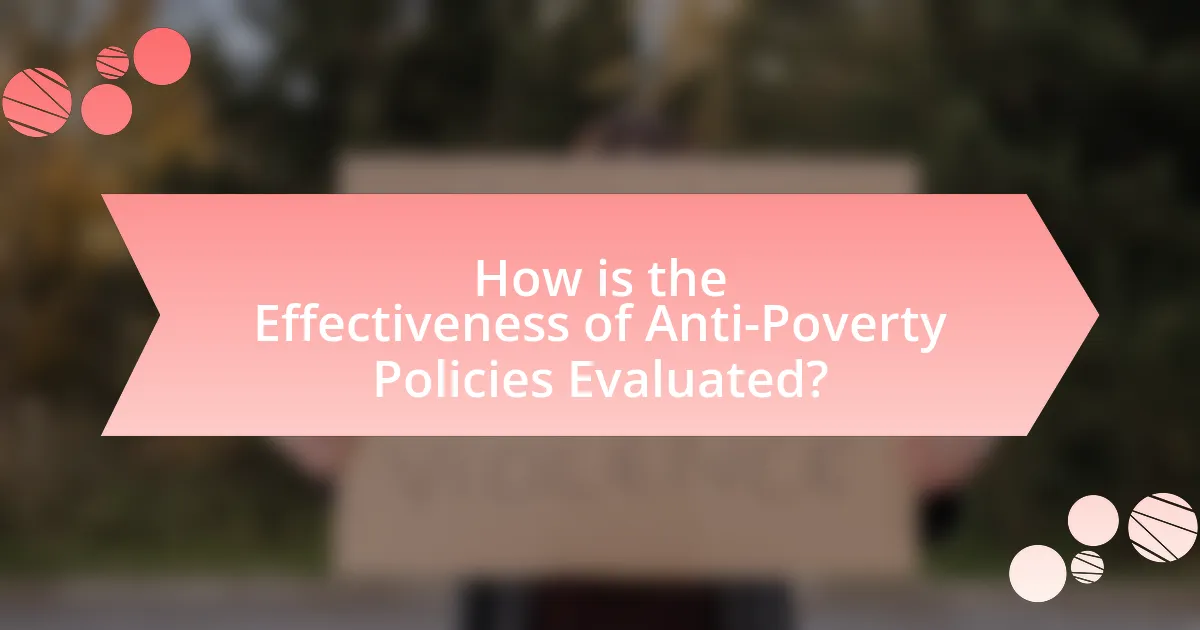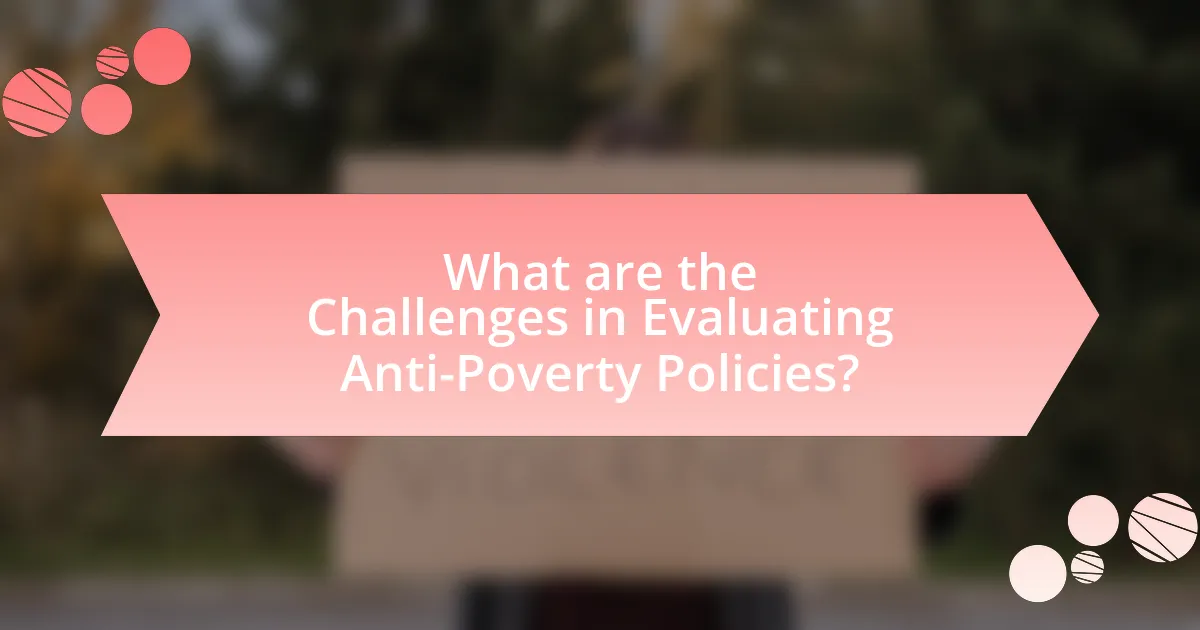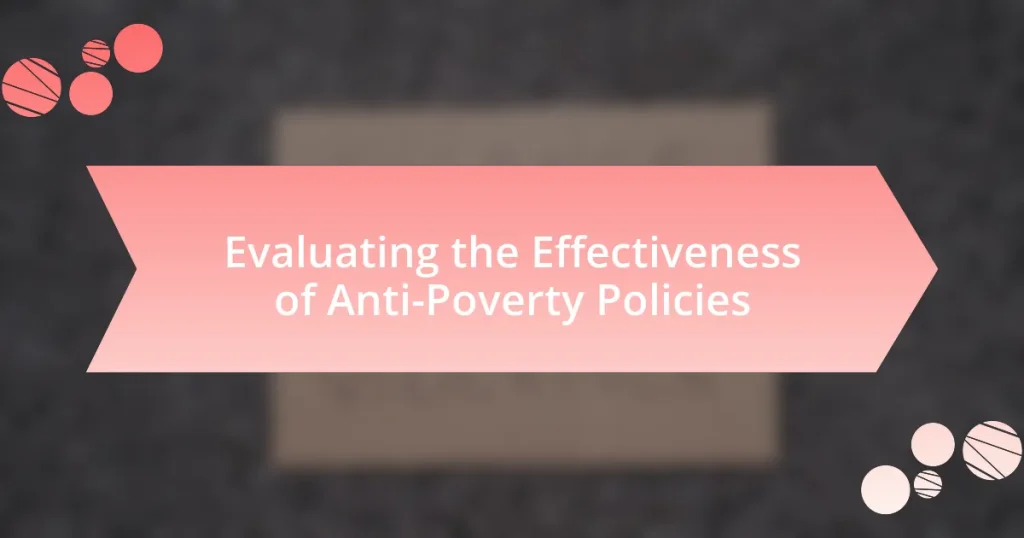Anti-poverty policies are government and organizational strategies designed to reduce poverty and enhance living conditions for low-income individuals and families. This article evaluates the effectiveness of these policies, examining their objectives, types, and the demographics they target. It discusses the methodologies used to assess their impact, including quantitative and qualitative evaluations, and highlights the challenges faced in measuring success. Additionally, the article explores how findings from evaluations can inform future policy design and improve strategies for poverty alleviation.

What are Anti-Poverty Policies?
Anti-poverty policies are strategies and programs implemented by governments and organizations aimed at reducing poverty and improving the living conditions of low-income individuals and families. These policies can include direct financial assistance, such as welfare benefits and food stamps, as well as indirect measures like education and job training programs, healthcare access, and affordable housing initiatives. Evidence shows that countries with comprehensive anti-poverty policies, such as Sweden and Denmark, have significantly lower poverty rates compared to those with minimal support systems, demonstrating the effectiveness of such policies in alleviating poverty.
How do Anti-Poverty Policies aim to reduce poverty?
Anti-poverty policies aim to reduce poverty by providing financial assistance, improving access to education, and creating job opportunities. These policies often include direct cash transfers, food assistance programs, and subsidized housing, which help to alleviate immediate financial burdens on low-income families. For instance, the Supplemental Nutrition Assistance Program (SNAP) in the United States has been shown to lift millions out of poverty by providing essential food resources. Additionally, initiatives like the Earned Income Tax Credit (EITC) incentivize work and increase disposable income for low-wage earners, effectively reducing poverty rates. Studies indicate that such policies can significantly decrease poverty levels; for example, the EITC has been credited with reducing poverty among families with children by approximately 25%.
What are the key objectives of Anti-Poverty Policies?
The key objectives of Anti-Poverty Policies are to reduce poverty levels, improve access to essential services, and promote economic opportunities for marginalized populations. These policies aim to alleviate immediate hardships through financial assistance and social safety nets while fostering long-term solutions such as education, job training, and healthcare access. For instance, the World Bank reports that targeted cash transfer programs have successfully lifted millions out of extreme poverty by providing direct financial support to low-income families, thereby enhancing their ability to invest in education and health.
How do these policies target different demographics?
Anti-poverty policies target different demographics by tailoring benefits and services to specific needs based on factors such as age, income level, and geographic location. For instance, programs like Supplemental Nutrition Assistance Program (SNAP) primarily assist low-income families, while Social Security benefits focus on elderly individuals. Research indicates that targeted interventions, such as housing assistance for low-income families in urban areas, effectively reduce poverty rates among those demographics. Additionally, data from the U.S. Census Bureau shows that policies aimed at single-parent households have led to a significant decrease in poverty levels within that group, highlighting the effectiveness of demographic-specific strategies.
What types of Anti-Poverty Policies exist?
Various types of anti-poverty policies exist, including income support programs, education and job training initiatives, healthcare access improvements, and housing assistance. Income support programs, such as cash transfers and food assistance, directly provide financial aid to low-income individuals and families, helping to alleviate immediate financial burdens. Education and job training initiatives aim to enhance skills and employability, thereby increasing long-term earning potential. Healthcare access improvements focus on ensuring that low-income populations receive necessary medical services, which can prevent health-related financial crises. Housing assistance programs, including subsidies and public housing, help secure stable living conditions for those in need. These policies are designed to address the multifaceted nature of poverty and have been shown to reduce poverty rates when effectively implemented.
What are the differences between cash transfer programs and in-kind assistance?
Cash transfer programs provide direct monetary assistance to individuals or families, allowing them to spend the funds according to their specific needs, while in-kind assistance delivers goods or services directly, such as food, clothing, or healthcare. Cash transfers offer flexibility and empower recipients to make choices that best suit their circumstances, which can lead to improved well-being and economic stability. In contrast, in-kind assistance can ensure that aid is used for essential needs but may not account for individual preferences or local market conditions. Research indicates that cash transfers can lead to greater economic growth and poverty reduction compared to in-kind assistance, as evidenced by studies showing that cash transfers can stimulate local economies and improve household consumption patterns.
How do employment programs contribute to poverty alleviation?
Employment programs contribute to poverty alleviation by providing individuals with job opportunities, skills training, and access to resources that enhance their employability. These programs directly address unemployment, which is a significant factor in poverty, by facilitating the transition of individuals from welfare dependency to self-sufficiency through stable employment. For instance, a study by the National Bureau of Economic Research found that participants in job training programs experienced a 10% increase in earnings compared to non-participants, demonstrating the effectiveness of such initiatives in improving financial stability. Additionally, employment programs often include support services like childcare and transportation assistance, further enabling individuals to maintain employment and reduce poverty levels.

How is the Effectiveness of Anti-Poverty Policies Evaluated?
The effectiveness of anti-poverty policies is evaluated through a combination of quantitative and qualitative methods, including impact assessments, statistical analysis, and case studies. Impact assessments measure the direct effects of policies on poverty rates, often using control groups to compare outcomes. Statistical analysis involves examining data trends over time, such as changes in income levels, employment rates, and access to services, to determine the correlation between policy implementation and poverty reduction. Case studies provide in-depth insights into specific programs, highlighting successes and challenges faced in different contexts. These evaluation methods are supported by empirical evidence, such as the World Bank’s findings that targeted cash transfer programs can reduce poverty by up to 30% in certain regions.
What metrics are used to assess the effectiveness of these policies?
Metrics used to assess the effectiveness of anti-poverty policies include poverty rates, income inequality indices, employment rates, and access to essential services. Poverty rates, measured by the percentage of the population living below the poverty line, provide a direct indication of the impact of policies on poverty alleviation. Income inequality indices, such as the Gini coefficient, assess the distribution of income among the population, reflecting the effectiveness of policies in promoting equitable growth. Employment rates indicate the success of policies in creating job opportunities, while access to essential services, including healthcare and education, evaluates the broader social impact of anti-poverty initiatives. These metrics collectively offer a comprehensive view of policy effectiveness in reducing poverty and improving living standards.
How do poverty rates and income levels serve as indicators?
Poverty rates and income levels serve as critical indicators of economic health and social well-being. Poverty rates reflect the percentage of the population living below a defined income threshold, highlighting the extent of economic deprivation. For instance, the U.S. Census Bureau reported a poverty rate of 11.4% in 2020, indicating significant portions of the population facing financial hardship. Income levels, on the other hand, provide insight into the average earnings within a community, influencing access to resources and opportunities. According to the World Bank, higher income levels correlate with improved health outcomes and educational attainment, demonstrating the interconnectedness of economic status and quality of life. Together, these indicators inform policymakers about the effectiveness of anti-poverty initiatives and guide resource allocation to address economic disparities.
What role do qualitative assessments play in evaluation?
Qualitative assessments play a crucial role in the evaluation of anti-poverty policies by providing in-depth insights into the experiences and perceptions of affected individuals. These assessments capture the complexities of human behavior and social dynamics that quantitative data alone cannot reveal, allowing evaluators to understand the contextual factors influencing policy effectiveness. For instance, qualitative methods such as interviews and focus groups can uncover barriers to accessing services or highlight the unintended consequences of policies, thereby informing more effective interventions. Research has shown that integrating qualitative assessments with quantitative measures leads to a more comprehensive evaluation framework, enhancing the overall understanding of policy impacts and improving decision-making processes.
What methodologies are commonly used in evaluations?
Common methodologies used in evaluations include randomized controlled trials (RCTs), quasi-experimental designs, and mixed-methods approaches. RCTs are considered the gold standard for assessing causal impacts, as they randomly assign participants to treatment and control groups, minimizing bias. Quasi-experimental designs, such as propensity score matching, are employed when randomization is not feasible, allowing for comparison between groups with similar characteristics. Mixed-methods approaches combine quantitative and qualitative data, providing a comprehensive understanding of program effectiveness. These methodologies are widely recognized in the field of evaluation for their rigor and ability to produce reliable findings.
How do randomized control trials contribute to understanding policy impact?
Randomized control trials (RCTs) significantly enhance the understanding of policy impact by providing rigorous evidence on causal relationships between interventions and outcomes. RCTs achieve this by randomly assigning participants to treatment and control groups, which helps eliminate selection bias and ensures that differences in outcomes can be attributed to the policy being evaluated. For instance, a study published in the American Economic Journal demonstrated that cash transfer programs effectively reduce poverty levels, with RCTs showing a 20% increase in household consumption among recipients compared to non-recipients. This method allows policymakers to make informed decisions based on empirical data, ultimately leading to more effective anti-poverty strategies.
What are the limitations of observational studies in this context?
Observational studies in the context of evaluating the effectiveness of anti-poverty policies have several limitations, primarily including the inability to establish causation, potential for bias, and confounding variables. These studies often rely on existing data without random assignment, making it difficult to determine whether observed effects are directly due to the policies implemented or other external factors. For instance, socioeconomic factors such as education and employment status can influence outcomes, leading to misleading conclusions. Additionally, selection bias may occur if the groups being compared are not equivalent, further complicating the interpretation of results. These limitations highlight the challenges in drawing definitive conclusions about the effectiveness of anti-poverty policies based solely on observational data.

What are the Challenges in Evaluating Anti-Poverty Policies?
Evaluating anti-poverty policies faces several challenges, primarily due to the complexity of poverty itself. One significant challenge is the difficulty in establishing clear metrics for success, as poverty is influenced by various social, economic, and environmental factors. For instance, the World Bank highlights that measuring poverty requires not only income levels but also access to education, healthcare, and employment opportunities. Additionally, the long-term impacts of these policies can be hard to assess, as immediate results may not reflect sustained changes in poverty levels. Furthermore, data collection can be inconsistent or biased, leading to unreliable evaluations. The lack of standardized methodologies across different regions complicates comparisons and generalizations about policy effectiveness.
What factors complicate the evaluation process?
The evaluation process of anti-poverty policies is complicated by several factors, including the diversity of poverty experiences, the complexity of social systems, and the variability in data quality. The diversity of poverty experiences means that individuals and communities face unique challenges, making it difficult to create a one-size-fits-all evaluation framework. The complexity of social systems involves multiple interacting variables, such as economic conditions, education, and health, which can obscure the direct impact of specific policies. Additionally, variability in data quality, including inconsistencies in data collection methods and reporting standards, can hinder accurate assessments of policy effectiveness. These factors collectively create challenges in isolating the effects of anti-poverty initiatives and drawing reliable conclusions about their success.
How do external economic conditions affect evaluation outcomes?
External economic conditions significantly influence evaluation outcomes by shaping the context in which anti-poverty policies are assessed. For instance, during economic downturns, increased unemployment rates can lead to higher poverty levels, which may skew the effectiveness of policies aimed at alleviating poverty. Research indicates that evaluations conducted in times of economic distress often reveal less favorable outcomes due to external factors such as reduced funding and increased demand for services, as seen in the 2008 financial crisis where many anti-poverty programs struggled to meet heightened needs. Thus, the economic environment directly impacts the perceived success or failure of these policies, making it essential to consider these conditions when interpreting evaluation results.
What challenges arise from data collection and analysis?
Challenges in data collection and analysis for evaluating anti-poverty policies include issues of data quality, accessibility, and representativeness. Data quality can be compromised by inaccuracies or inconsistencies in the information collected, which can lead to misleading conclusions about policy effectiveness. Accessibility challenges arise when relevant data is not readily available or is difficult to obtain due to bureaucratic barriers or privacy concerns. Additionally, representativeness is a significant challenge, as data may not adequately reflect the diverse experiences of all demographic groups affected by poverty, leading to biased results. For instance, a study by the World Bank highlights that inadequate data on marginalized populations can skew policy evaluations, making it difficult to assess the true impact of interventions.
How can evaluations be improved for better insights?
Evaluations can be improved for better insights by incorporating mixed-method approaches that combine quantitative and qualitative data. This method allows for a more comprehensive understanding of the effectiveness of anti-poverty policies, as quantitative data provides measurable outcomes while qualitative data offers context and depth. Research by the World Bank indicates that evaluations using mixed methods yield richer insights, as they capture the complexities of human behavior and social dynamics that purely quantitative approaches may overlook. By integrating these methodologies, evaluators can enhance the relevance and applicability of their findings, leading to more informed policy decisions.
What best practices can enhance the reliability of evaluations?
To enhance the reliability of evaluations, employing a mixed-methods approach is essential. This approach combines quantitative and qualitative data, allowing for a comprehensive understanding of the evaluated programs. Research indicates that using both data types can mitigate biases inherent in singular methods, leading to more robust findings (Creswell & Plano Clark, 2017). Additionally, establishing clear evaluation criteria and using standardized measurement tools ensures consistency across evaluations, further enhancing reliability. Implementing these best practices can significantly improve the accuracy and trustworthiness of evaluations in assessing anti-poverty policies.
How can stakeholder engagement improve evaluation processes?
Stakeholder engagement can improve evaluation processes by ensuring that diverse perspectives and insights are incorporated, leading to more comprehensive assessments. Engaging stakeholders, such as community members, policymakers, and service providers, allows evaluators to gather relevant data that reflects the actual experiences and needs of those affected by anti-poverty policies. Research indicates that participatory evaluation approaches, which involve stakeholders in the evaluation design and implementation, enhance the validity and reliability of findings, as they are grounded in real-world contexts. For instance, a study by Cousins and Earl (1995) in “Participatory Evaluation in Education: A Review of the Literature” highlights that stakeholder involvement increases ownership and utilization of evaluation results, ultimately leading to more effective policy adjustments and improvements.
What are the practical implications of evaluating Anti-Poverty Policies?
Evaluating anti-poverty policies has significant practical implications, including the ability to assess their effectiveness, efficiency, and impact on target populations. By systematically analyzing these policies, stakeholders can identify which strategies successfully reduce poverty and which do not, allowing for informed decision-making regarding resource allocation. For instance, a study by the National Bureau of Economic Research found that cash transfer programs significantly improved household income and health outcomes, demonstrating the effectiveness of certain anti-poverty measures. Additionally, evaluations can reveal unintended consequences, such as dependency on aid, enabling policymakers to refine programs for better outcomes. Overall, the evaluation process is crucial for optimizing anti-poverty initiatives and ensuring they meet their intended goals.
How can findings from evaluations inform future policy design?
Findings from evaluations can inform future policy design by providing evidence-based insights into what strategies are effective in reducing poverty. For instance, evaluations of anti-poverty programs, such as the U.S. Earned Income Tax Credit, have shown significant positive impacts on employment and income levels among low-income families. These findings enable policymakers to refine existing programs or develop new initiatives that are more likely to succeed, ensuring resources are allocated efficiently. Additionally, data from evaluations can highlight areas where policies may be falling short, allowing for targeted improvements that enhance overall effectiveness in combating poverty.
What strategies can policymakers adopt based on evaluation results?
Policymakers can adopt strategies such as evidence-based decision-making, targeted resource allocation, and program adjustments based on evaluation results. Evidence-based decision-making involves using data from evaluations to inform policy choices, ensuring that interventions are grounded in proven effectiveness. Targeted resource allocation allows policymakers to direct funding and support to the most successful programs, maximizing impact on poverty reduction. Program adjustments enable the refinement of existing initiatives based on feedback and outcomes, enhancing their effectiveness. For instance, a study by the National Bureau of Economic Research found that programs adjusted based on evaluation feedback showed a 25% increase in effectiveness in reducing poverty levels.
